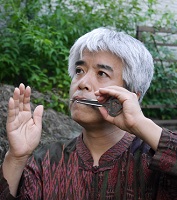“The khomus is my red deer on which I fly through the middle world” (Khomus in the shamanic practice of Tuva: Research issues)
DOI:
https://doi.org/10.25178/nit.2017.2.7Keywords:
khomus; Jew’s harp; khomus player; Tuvan music; shaman; S. Vainshtein; xöömei; Tyva; shamanic practiceAbstract
The author first got acquainted with Tuvan music in 1991, at the 2nd International Congress of Jew’s Harp Music in Yakutia, Russia. Among other ethnomusical bands from Russia’s various regions and CIS states, the Tuvan band stood out with its special techniques of playing the khomus (Jew’s harp) and of throat singing which accompanied their music. One of them, Gennadii Chash, later tutored the author in throat singing during the latter’s visits to Tuva, where he also met Tuvan musicians and ethnomusicologists. The author attended a number of symposia on music in Tyva and researched the Tuvan khomus playing techniques. He also co-produced a CD with their audio recordings (2013).
Of special interest for the author are the khomus playing techniques as they are used in shamanic practice. The author follows the study of the shamanic rituals as they appeared in the works of the Russian scholar Sevyan Vainshtein, in the videos made during his ethnographic field studies, and also reflects on his own observations.
References
Kolltveit, G. (2006) Jew’s Harps in European Archaeology. Archaeopress, Publishers of British Archaeological Reports, Oxford.
Tadagawa, L. (2016) Asian Excavated Jew’s Harps: A Checklist (1) - Lamellate Jew’s Harps (1). In: Institute of Ethnomusicology Bulletin of Tokyo College of Music, Vol. 5, pp. 57–70.
Tadagawa, L. (2017) Asian Excavated Jew’s Harps: A Checklist (2) - Lamellate Jew’s Harps (2). In: Institute of Ethnomusicology Bulletin of Tokyo College of Music, Vol. 6, рр. 57–68.
Vainshtein, S. I. (1991) Mir kochevnikov tsentra Asii [The World of Nomads of the Center of Asia]. Moscow, Nauka. 296 p. (In Russ.).
Markus, S. V. (2006) Tuva: Slovar’ kultury [Tuva: Dictionary of Culture]. Moscow, Akademicheskii proekt. 832 p. (In Russ.)
Suzukei, V. Iu. (2010) Khomus in the Traditional Culture of Tuvans. Kyzyl, Tyvapoligraf. 228 p. (In Russ.).
Published
How to Cite
Issue
Section

Author(s) license holder(s) grant rights for their work to the journal (grantee of a license) under the simple non-exclusive open license in accordance with Art. 1286.1 «Open license for a research work, work of literature or fine arts», Civil Code of the Russian Federation.
New Research of Tuva publishes articles under the Creative Commons Attribution-NonCommercial license (CC BY-NC).
Since it is an open license, author(s) reserve the right to upload the article to their institutional repository, submit it to another journal (if it allows republications), or republish it on their own website (in full, or in part).
However, several conditions apply here:
a) The republished version must always contain the name(s) and affiliation(s) of the author(s), the original title and the hyperlink to the original version on the New Research of Tuva website;
b) It must be in open access, free of charge, and no category of readers must be in any way whatsoever advantaged over general readership.
c) should the contribution be submitted elsewhere by its author(s) without substantial modification (30% or more of original text unchanged), the body of the article should contain a disclaimer that the original version was published in New Research of Tuva (with a link to the respective page)
The CC-BY-NC is a non-revocable license which applies worldwide and lasts for the duration of the work’s copyright.









